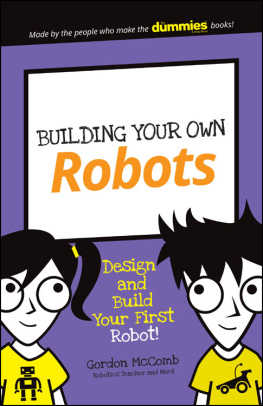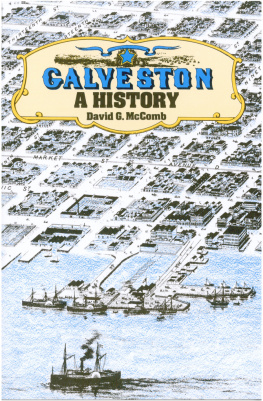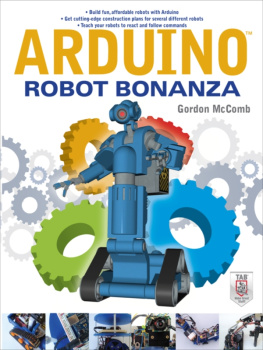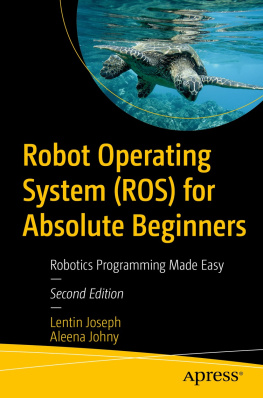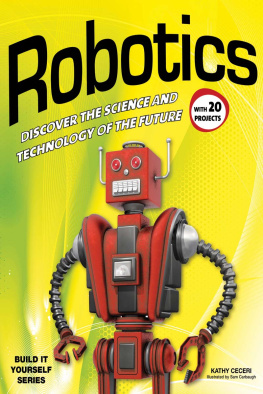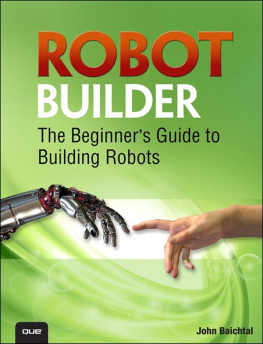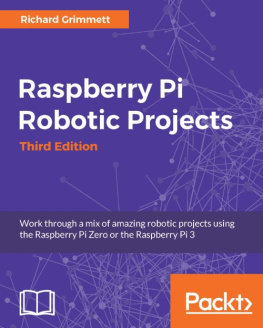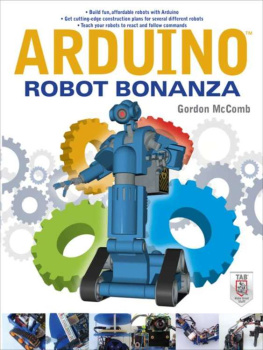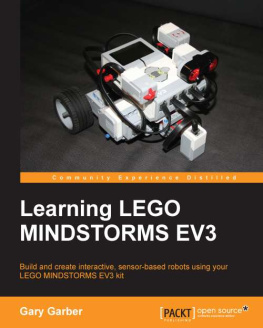ROBOT BUILDERS BONANZA
ABOUT THE AUTHOR
Gordon McComb has written 65 books and thousands of magazine articlesover a million copies of his books are in print, in more than a dozen languages. For 13 years, Gordon wrote a weekly syndicated newspaper column on computers and high technology, which reached several million readers worldwide. Hes a regular contributor to SERVO Magazine and other publications, and maintains an active Web site dedicated to teaching the art and science of robot building.
ROBOT BUILDERS BONANZA
GORDON McCOMB
FOURTH EDITION


Copyright 2011, 2001, 1987 by Gordon McComb. All rights reserved. Except as permitted under the United States Copyright Act of 1976, no part of this publication may be reproduced or distributed in any form or by any means, or stored in a database or retrieval system, without the prior written permission of the publisher.
ISBN: 978-0-07-175035-6
MHID: 0-07-175035-5
The material in this eBook also appears in the print version of this title: ISBN: 978-0-07-175036-3, MHID: 0-07-175036-3.
All trademarks are trademarks of their respective owners. Rather than put a trademark symbol after every occurrence of a trademarked name, we use names in an editorial fashion only, and to the benefit of the trademark owner, with no intention of infringement of the trademark. Where such designations appear in this book, they have been printed with initial caps.
McGraw-Hill eBooks are available at special quantity discounts to use as premiums and sales promotions, or for use in corporate training programs. To contact a representative please e-mail us at bulksales@mcgraw-hill.com.
Information contained in this work has been obtained by The McGraw-Hill Companies, Inc. (McGraw-Hill) from sources believed to be reliable. However, neither McGraw- Hill nor its authors guarantee the accuracy or completeness of any information published herein, and neither McGraw- Hill nor its authors shall be responsible for any errors, omissions, or damages arising out of use of this information. This work is published with the understanding that McGraw- Hill and its authors are supplying information but are not attempting to render engineering or other professional services. If such services are required, the assistance of an appropriate professional should be sought.
TERMS OF USE
This is a copyrighted work and The McGraw-Hill Companies, Inc. (McGraw-Hill) and its licensors reserve all rights in and to the work. Use of this work is subject to these terms. Except as permitted under the Copyright Act of 1976 and the right to store and retrieve one copy of the work, you may not decompile, disassemble, reverse engineer, reproduce, modify, create derivative works based upon, transmit, distribute, disseminate, sell, publish or sublicense the work or any part of it without McGraw-Hills prior consent. You may use the work for your own noncommercial and personal use; any other use of the work is strictly prohibited. Your right to use the work may be terminated if you fail to comply with these terms.
THE WORK IS PROVIDED AS IS. McGRAW-HILL AND ITS LICENSORS MAKE NO GUARANTEES OR WARRANTIES AS TO THE ACCURACY, ADEQUACY OR COMPLETENESS OF OR RESULTS TO BE OBTAINED FROM USING THE WORK, INCLUDING ANY INFORMATION THAT CAN BE ACCESSED THROUGH THE WORK VIA HYPERLINK OR OTHERWISE, AND EXPRESSLY DISCLAIM ANY WARRANTY, EXPRESS OR IMPLIED, INCLUDING BUT NOT LIMITED TO IMPLIED WARRANTIES OF MERCHANTABILITY OR FITNESS FOR A PARTICULAR PURPOSE. McGraw-Hill and its licensors do not warrant or guarantee that the functions contained in the work will meet your requirements or that its operation will be uninterrupted or error free. Neither McGraw-Hill nor its licensors shall be liable to you or anyone else for any inaccuracy, error or omission, regardless of cause, in the work or for any damages resulting therefrom. McGraw-Hill has no responsibility for the content of any information accessed through the work. Under no circumstances shall McGraw-Hill and/or its licensors be liable for any indirect, incidental, special, punitive, consequential or similar damages that result from the use of or inability to use the work, even if any of them has been advised of the possibility of such damages. This limitation of liability shall apply to any claim or cause whatsoever whether such claim or cause arises in contract, tort or otherwise.
For Lane and Firen,
keeping the legacy alive
CONTENTS
to Locate Parts
ACKNOWLEDGMENTS
Once more Ive climbed the mountain. And once more I look back to those who have helped me turn my vision into reality.
To my friends at the San Diego robotics group; to John Boisvert and his amazing robotics emporium; to Mike Keesling, Alex Brown, and Tony Ellis; to those Ive met over the years on the comp.robotics.misc newsgroup for their great ideas, wisdom, support, and advice; and to Frits Lyneborg and the entire LetsMakeRobots.com community;
To Russell Cameron, roboteer extraordinaire, and to Jan Malasek of Pololu, Mario Tremblay of Robotshop, Clive Seager of Revolution Education, Jim Frye of Lynxmotion, Nathan Seidle of SparkFun, Gerry Coe of Devantech, and Claudia and the crew at DAGU;
To the makers and keepers of the Arduino, PICAXE, BASIC Stamp, FIRST CAD Library, and Fritzing for great tools, great software, and great art;
To Judy Bass and the editors at McGraw-Hill, whove put up with me all these years; to my agents at Waterside Productions; and to Bill Gladstone who first helped me take on this project way back in 1985 (how time flies!);
And last but certainly not least, to my wife, Jennifer.
I offer my heartfelt thanks, one and all.
PHOTO AND ILLUSTRATION CREDITS
Adafruit Industries (
Christopher Schantz (
Cooper Industries (
Devantech (
General Electric:
Hitec RCD (
Lynxmotion (
iRobot Corporation (
Maxbotics Inc (
Miga Motor Company (
Parallax Inc (
Pitsco Education (
RoboRealm (
Pololu (
Russell Cameron/DAGU Hi-Tech Electronic:
Scott Edwards Electronics (
SparkFun Electronics (
The author expresses his deepest gratitude for the use of 3D CAD objects developed by Ed Sparks at FirstCadLibrary.com; to the developers and contributors of the Fritzing project ( www.fritzing.org ); for public domain art developed by Wikipedia user Inductiveload, and others; and to the talented artists of the 3D models used throughout this book.
This publication contains images used under license from Corel Corporation, Hemera Technologies, Shutterstock.com, and other licensors.
INTRODUCTION
Robotics: Inspired Technology
Which of these fields are involved in robotics? You may choose from the following: engineering, electronics, psychology, sociology, biology, physics, artificial intelligence, math, art, mechanical design, mechanical construction, computer programming, sound synthesis, vision, ultrasonics, linguistics, microelectronics, process control, system automation, musicology.
If you said all of them, youre right.
And if you think I missed some, I have. Robotics is all of these things, and much more. Its popularity comes from all the disciplines it embraces. When you build a robot, you can explore everything from mechanical design to computer engineering to behavioral science.
Next page

